Like many, many others, I grew up watching Back to the Future. It was a beloved staple in my household, one of the films I’ve seen the most in my lifetime, and definitely one I can quote verbatim. No matter how many times I see it, it never ceases to make me laugh. Christopher Lloyd and Michael J. Fox make the best team—and I would love to meet them someday.
That’s part of the film’s charm. Even though it’s been nearly four decades since the film was released (nearly ten years more than the amount of years Marty traveled in time!), audiences still love it, and understandably so. The humor and the chemistry are my personal favorites. You can have the perfect script, but unless you have the right actors and chemistry, it’ll never do it justice.
Even after thousands of viewings, I still discover new things. Last year, for instance, my brother pointed out that once Marty returns from 1955, the mall where he met Doc is no longer “Twin Pines” but “Lone Pine” because Marty took out one of the trees on his way out of Peabody’s barn. It’s a fun little Easter egg and it highlights the film’s incredible attention to detail. Even though Marty tried not to change the past too much, there’s tidbits here and there that left an impact apart from his parents finally getting together and his father’s confidence boost by the film’s conclusion.
The Allure of Time Travel
One of the things that people can universally relate to is their wonder for time travel. Where would they go, what would they do? Who would they want to meet? Would they dare make changes, or would they watch from the sidelines? Other films of the era explore the same phenomenon, but Back to the Future does it best.
One of the things that pops up in my time-travel conversations with people the most is the fact that people would use the DeLorean to see lost loved ones in a time past. I would, too. Another is to see what a different decade was like. Imagine going back to Marty’s time now—what a culture shock that would be! Nonetheless, I’d get in the car, personally. I’d go see Prince in concert; I’d meet my teenage parents; I’d go shopping. Lots of things.
It’s forever a universally relevant conversation. If ever time traveling becomes available, wouldn’t it be cool to experience another lifetime? Ensuring you have a way back, of course, lest you rely on a bolt of lightning at a precise moment to get back home.
Doc Brown certainly had big plans; understandably, he desired to see the future. He wanted to see the progress of mankind, as he puts it. In real time, I think he’d be disappointed at our lack of flying cars, but having the ability to make movies on one’s phone is pretty neat.

That’s another interesting aspect about the film’s coverage of time traveling: the different perspectives and experiences between Doc and Marty themselves. Doc, on one hand, was prepared to travel through time. He had enough plutonium to make trips and was excited to see outside of his lifetime. He was thrilled to invent something that worked and that he could enjoy.
On the other hand, Marty was hesitant. He’s a young teen, and he’s not the scientist that Doc is. The DeLorean is not his invention; he only knows the little basics that Doc gave him before Marty found himself thirty years in the past. He’s scared and alone, in a time that he doesn’t understand outside of reruns of I Love Lucy or, as the film references, The Honeymooners. Not to mention the mix-up he finds himself in with his parents. The stakes are raised; his life literally depends on lightning (and his parents) in order to make it home, let alone exist.
It’s fate, in a way, because he just so happens to have the flyer with the information on the clock tower. Plus, he just so happens to know the story that ultimately convinces Doc that he’s not crazy—he really is from the future. Everything is laid out perfectly for him to get home, but there’s hard work to be done, and not just in setting up the DeLorean and the clock tower. Also, his very existence.
Quality Family Time
Granted, it’s uncomfortable to watch Marty be pursued by his mother, Lorraine (Lea Thompson) at times. Yet, it somehow heightens the humor of Marty squirming away and trying to direct her affections to George (Crispin Glover) instead. As a kid, the way everything played out somehow downplayed the awkwardness of that fact—at least, in my experience. Audiences knew that Marty pushing his father out of harm’s way would inevitably change things in a big way, but in Marty’s shoes, audiences would’ve done the same thing, no doubt. Marty didn’t realize at the time that he was jeopardizing his own existence, after all.
It turns out to be a good, although stressful, bonding time for father and son. Marty has to work hard to break George out of his shell and boost his confidence. In the process, Marty finds out he and his dad have more in common than he previously thought: they both have creative pursuits, George in writing and Marty in music. Marty spends a good amount of the film wondering how on Earth his parents ever ended up together given George’s stubbornness and insistence that he’d rather skip the dance; audiences do, too. If not for Marty’s intervention, how would George and Lorraine have ended up together in these alternate circumstances, if not for Lorraine’s father hitting George with his car?

The defining moment surprises audiences and Marty equally when George finally stands up to Biff and saves Lorraine in the parking lot while Marty is locked in a trunk. Somewhere inside, George had it in him all along to stand up to the bully, do the right thing, and win the girl. Luckily, Lorraine finally sees George in that moment. She can finally see that he is someone who will take care of her, and that he is a good man. A trust is established there, and Marty can finally breathe that sigh of relief.
While George had it in him all along to pursue Lorraine, Marty’s help definitely changed him in a big way. When Marty returns to 1985, George has published his first novel, and there’s a noticeable difference in family dynamics. Lorraine is not drinking excessively; Marty’s parents are happier together than they’ve ever been, and his siblings are more motivated to make something of themselves by extension. Marty helps himself as well in this instance; he’s reassured that he can do something significant, too. It gives him a confidence boost, especially after the brutal rejection he faced in the film’s beginning. If you don’t try, you’ll never get there.
Getting to know his parents better on different levels helped Marty understand why they were the way they were, too. It’s easy to forget that parents had whole lives before they had kids, or that they’re human, too. They have hardships and make mistakes. Getting to know them as teenagers was definitely a once-in-a-lifetime experience, and Marty made the most out of it. Not to mention, it was pretty smart that he took the opportunity to avoid future punishment for accidentally setting fire to the rug.
Marty should be proud of himself for helping his family have that better life. Biff has certainly got his just desserts; though, I wouldn’t be so quick to trust him with my car, as even George has to call him out on his conning.
The Dynamic Duo
Marty and Doc are just as recognizable a duo as the DeLorean is among movie cars. They’re an unusual yet functional team. They’re great together, balancing each other out. Doc is fun and eccentric, smart but impulsive–Marty surely would’ve talked him out of stealing plutonium from the dangerous Libyans had he known. Marty’s more on the cautious side, but he’s also smart and resourceful.
When I first saw the film, one of the things I wanted to know was how far back their friendship went. They had a good rapport, so obviously they’d known each other for some time. Yet, how did they meet? What made Marty want to help with Doc’s experiments? Doc strikes me as more of a loner than anything; he was probably happy to find someone interested in what he does, versus the usual treatment of being viewed as some kind of crackpot from the townspeople. However their friendship began, it’s easy to see it’s the stuff that makes a lifelong friendship (and well, given their ability to travel through time, a friendship even beyond a lifetime).

I love their loyalty to one another. Even in the middle of the night, Marty shows up at Twin Pines mall to see Doc’s newest invention. In the film’s end, Doc returns for Marty and Jennifer, wanting to help them straighten out their children’s futures because he cares so much about them. They help each other out without question.
That’s why it’s so devastating to see Doc rip up Marty’s letter, warning him of his impending murder in 1985. Marty rushes back in time a bit earlier to try to stop the tragedy himself but is too late. That heartbreaking moment shows the depth of their friendship; how much they mean to one another. It’s intensified when it turns out Doc is alive; he decided to read the letter after all, and he prepared accordingly with a bulletproof vest. His reasoning was what the Hell? but I always considered it more along the lines of If Marty wanted to tell me something that badly, it must be important enough to risk the future.
I loved that the film ended with the obvious: the best friends had more adventures to go on, especially now that there’s enough plutonium to get from one time to another. There’s more for both of them to learn from time, and from each other. Doc, in many ways, is like a surrogate parent to Marty, guiding him. Marty heavily relies on him and vice versa; they need each other to get out of the jams they find themselves in with time traveling. Yet, Doc has proved again and again that hard work means accomplishing your goals–in his case, goals beyond most anyone’s wildest dreams. Who wouldn’t be inspired by that?
Plus, both of them have many, many memorable moments in the films. From the first film, I personally love Doc’s freakout over 1.21 gigawatts, and Marty’s reaction to his first observation of the DeLorean (including the fact that the time machine itself was a DeLorean of all things!). Their facial expressions, their tone inflections, their quotes, their reactions–everything is absolutely dynamite, which only makes the story that much better.
Biff the Bully
Of course, Biff gets a mention. The persistent villain with appearances in all three films. Yet, in the first film Biff really shows off the nasty bully he is. Thomas F. Wilson nailed his part. Biff picks on those he views as weaker than himself (a classic bully move), but he’s especially brutal to George.
Everyone wants to beat the bully and see them get their karma. Back to the Future does that and more. Biff is shown up by Marty, he’s punched out in the parking lot by George in front of his classmates, and best of all, he gets manure not just on himself and his buddies, but also all over the inside of his car!

The recurring manure gag is one of my absolute favorite movie gags of all time. I love seeing Biff get his comeuppance. You’d think it’d get him to back off, but it only infuriates him more. Of course, it would—we wouldn’t have the memorable villain in Biff that we do if he’d simply given up by then. Biff’s intimidation tactics raise the stakes and give Marty something else to overcome. As we see throughout time, Biff only gets worse if given the right tools–and his relatives weren’t all that great, either. The guy never had an opportunity to be the good guy. Plus, he never learns.
Let’s not forget his memorable insults of “butthead” or “make like a tree and get out of here.” He screwed up the latter, which makes it that much more hilarious. The way Biff uses “butthead” is also different–for him, it’s like a term of endearment. He uses it as an insult but somehow you just snicker because it makes him look that much more like the ridiculous but hilarious bully that he is.
All in all, without Biff, Back to the Future just wouldn’t be the same. And poor George! Can you imagine your childhood bully torturing you all the way into adulthood? I couldn’t. I’m so glad that reign of terror ended when Marty helped his dad stand up to Biff. No one deserves that, and it shows how little maturity Biff really had, to be a bully even in his adult life.
Maybe he needed a few more life lessons involving manure?
Music & Other Details
I love Huey Lewis and the News. I obsessively listened to “Power of Love” and “Back in Time.” Eventually I branched out and discovered more of their music, which only made me love them more, but those particular songs are very sentimental to me because of the film.
A great soundtrack is a major contribution to any film. I consider Back to the Future one of the best ones to come out of the 1980s. Composer Alan Silvestri captured the moods and events with the perfect tones in each of his compositions.
I’ve seen plenty of reels on Instagram lately about how music can instantly change an overall scene—notably, there was one about the opening scene in The Shining. It looks innocent enough, a family traveling in the mountains, but the scary music gives away that something sinister lies ahead. If a happy tune had played instead, it would’ve clashed with the horror movie the opening scene was leading into.
One of my favorite compositions from Silvestri has to be “’85 Twin Pines Mall.” It perfectly captures the feeling as the Libyans approach; Doc and Marty are in danger! Doc, knowing what’s about to happen, instantly becomes frantic while Marty is initially confused, then horrified when he witnesses Doc’s murder. Both character’s feelings are captured eloquently on that track, as is the impending danger of the Libyans given the score’s increasing volume as they approach the parking lot.

The film got a lot of things right. The script, the casting, the crew, the music. No complaints here. There’s a multitude of reasons why movies last a lifetime, and why some are more iconic than others.
The DeLorean definitely makes this movie stand out. Whenever I see a DeLorean, this movie comes to mind, as I’m sure it does for fans everywhere. Especially today, when it’s rare to see a DeLorean in person.
Not to mention Marty’s outfit. I’ve seen people go all out on dressing up as Marty for Halloween or conventions or even just because. Jeans, sneakers, checkered shirt, and of course, that red vest that everyone in 1955 assumed was a life preserver. That vest being an example of a culture clash was brilliant; fashion was one of the many differences between the 1950s and the 1980s, after all.
Doc’s misunderstanding of the cultural meaning of “heavy” was funny as well. Plus, Marty’s own struggle with not understanding his own hometown—Hill Valley changed a lot in thirty years, after all. The house development where Marty lives didn’t even exist yet, and Doc’s road was named something entirely different in 1955. Not to mention technology and other cultural references—Marty’s uncle had no idea what a “rerun” was, after all.
I think it’d be interesting to see someone from 2023 go back to 1985 now. The technology aspect alone would be hilarious; not many people have used rotary phones in recent years, and there were no cell phones. Phone booths are almost never seen today, but they were plentiful in the 1980s. Same goes for televisions, microwaves, and fridges–there were no “smart” televisions or appliances yet. The cars and fashion and music, too—it’d be like stepping into an entirely different world. Perhaps the time traveler would feel like they’d changed planets rather than time and space continuums.
My takeaway from the film, overall, is that it teaches a great lesson. It’s never too late to change anything, especially for the better. Doc later says in the third film that no one’s future is written yet, so make it a great one. That lesson is carried through all the movies as Doc and Marty rush to fix the wrongdoings done in time—it’s never too late to start over and rewrite the future.



